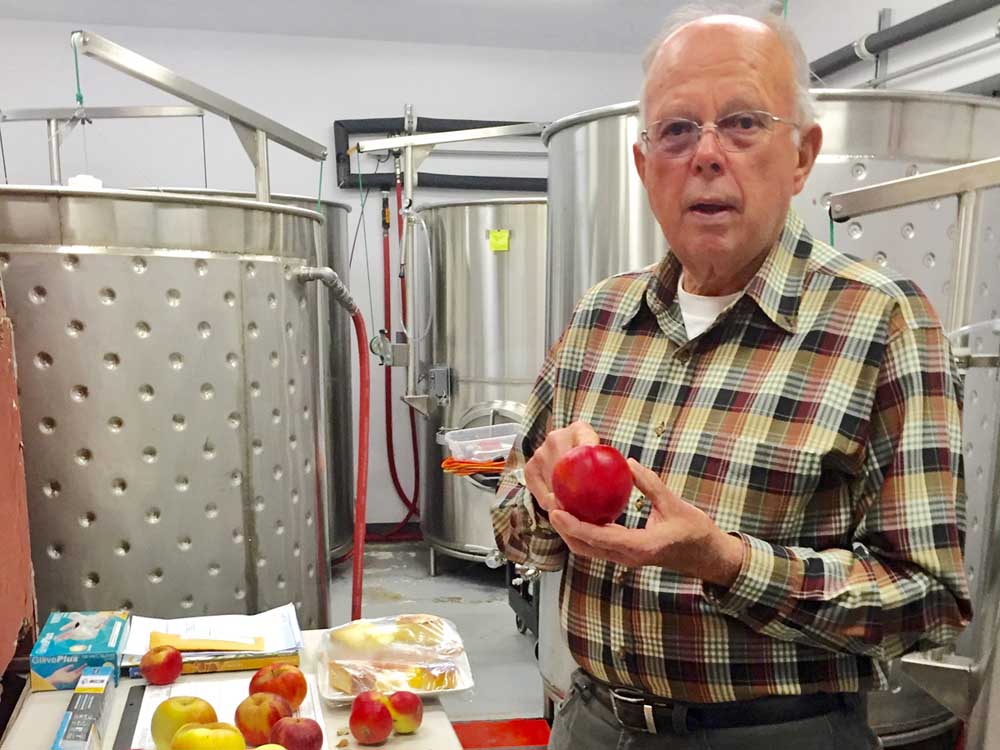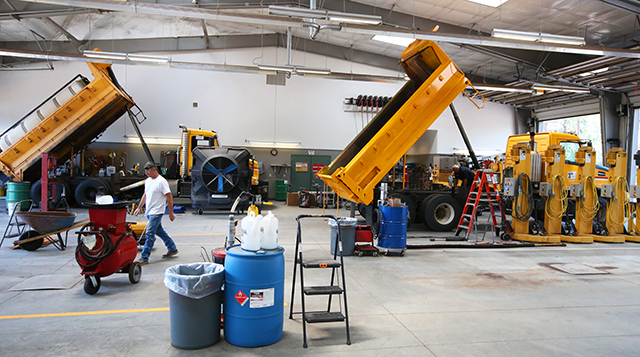Northwest Travel: Cider country
Published 12:00 am Sunday, November 8, 2015

- John Gottberg Anderson / For The BulletinPeter Ringsrud, owner of the Snowdrift Cider Co., displays a variety of cider apples that he blends in producing his unique hard ciders. Specific tannins, acids and aromas, he said, go into such commercial varieties as Orchard Select and Cliffbreaks.
I’ve watched with curiosity in recent years as the production of hard cider in the United States, and especially in the Pacific Northwest, has grown on the coattails of beer, wine and custom spirits.
A favored beverage in the United Kingdom for centuries, alcoholic cider achieved some popularity in this country during the Prohibition years, then faded into the background until recently. Now, with the growth of interest in all manner of beverages, it has re-emerged.
Trending
While apples are grown throughout the Northwest, and there are cider producers in towns of all sizes, including Bend, three regions stand out as being especially significant for their orchards: Wenatchee and Yakima, in Washington; and Hood River, on the Oregon side of the Columbia River Gorge. I visited cideries in each of these areas on a recent trip through the Columbia and Yakima River valleys.
Snowdrift Cider
Wenatchee and its sister city of East Wenatchee, with a metropolitan population of around 50,000, straddle the Columbia near the geographic center of Washington. Orchards extend north to the Lake Chelan region and west through Cashmere to Leavenworth.
At the Snowdrift Cider Co. on a rural hillside southeast of the urban area, I got my early education in cider-making from father and son Peter and Lars Ringsrud. Perhaps my most important first lesson was the discovery that the apples used in most hard ciders are distinctly different from sweet dessert apples.
Shortly after my arrival at the garage that served as Snowdrift’s first production facility, the Ringsruds took me for a walk through the 2-acre test orchard beside their farmhouse home. It is planted with 35 different varieties of cider apples, many of them grafted onto the root stock of trees that once bore Golden Delicious and Granny Smith apples.
When cider is made from dessert fruit, said Peter Ringsrud, an orchardist (like his father and grandfather) for more than 40 years, “Yeast removes sugar, and you’re left with an acidic, only slightly alcoholic beverage.” A far better solution, he said, is to blend the distinctive flavor profiles of true cider apples, with their tannins, acids and aromas.
Trending
Most of these apples came to the United States from England and France, where they have been used in cider for many centuries. Lars Ringsrud pulled a variety called Porter’s Perfection off a tree and handed it to me. I took a bite. “It has a lot of tannins,” he said, as I watched the white of the apple quickly turn brown. “It has some sweetness, but also a certain astringency. It dries in your mouth.”
These qualities, he said, make Porter’s a fine cider apple. It is considered a “bittersharp” fruit, one of four types, along with bittersweet, sharp and sweet, that are widely blended in cider production. “A lot of cider-making is in the art of blending,” Peter Ringsrud said.
Among his favorites, he said, are the bittersweet Bulmer’s Norman and Yarlington Mill, the bittersharp Kingston Black and Golden Russet, the consistent Dabinett and the estate Snowdrift Crab Apple, which has twice the sugar of many other varieties.
Growing business
Today, Snowdrift produces six commercial ciders, each using different apples and blends ranging from pale straw to deep amber in color. Its mainstay, Orchard Select, is light in color, with tropical overtones. Cliffbreaks is robust. Red Cider has a cranberry edge.
“Our focus is to have the fruit speak through the cider,” said Peter Ringsrud. The process of making cider takes nine to 10 months, he said: The apples are pressed for juice, fermented with added yeast and nutrients, chilled to remove lees, then matured for six months in stainless steel, as the fruit’s tannins recombine. Before bottling in July, the cider-makers add “a little carbonation to lift the aroma into the nasal cavities,” Lars Ringsrud said.
In 2014, Snowdrift produced the equivalent of 6,100 cases of cider, divided equally between bottles and kegs. But the little company is growing so rapidly that it is already planning an expansion of a new production facility. Snowdrift Cider is being shipped to California and the northeastern United States, and it won’t be long, Peter Ringsrud predicted, that they’ll be producing 40,000 case equivalents.
“There was no industry when we started in 2008,” he said. “Up until two to three years ago, cider was an unknown entity. There were only five cideries in the Northwest. Now, there are more than 50.”
And more are on the way. Just north of East Wenatchee, beside the Columbia River, Lisa Bee’s is one of those. Once a seasonal fruit stand, it was purchased last year by Oroville orchardist Jeff Bouilloun and his daughter Lisa Stanton.
“I saw more potential than a fruit stand,” said Stanton, a former dental hygienist with two small children. So she set to work turning it into a budget-priced bistro, bakery and produce market, complete with a children’s play area and a dog park. “My goal is to be the best kid destination in town.”
Already, Lisa Bee’s presses apples and pears from her family’s farm for sweet ciders. Stanton plans to move into hard cider production next year. “We already have all the equipment for it,” she said. “We have the square footage and the storage space. We’d be crazy not to do it.”
Tieton Cider
One of the oldest and largest producers of hard ciders in the Pacific Northwest is the Tieton Cider Works, whose new facility and tasting room in Yakima far exceeds the capacity of its original hub near the country village of Tieton.
Tieton planted its first cider apples in 2006 and made its first commercial release three years later. “Our production has grown from 7,000 case equivalents in 2013 to 70,000 in 2015,” said brand manager LeAnn Wane. “That’s about 200,000 gallons of cider this year.”
About a third of the distribution of Tieton’s 13 commercial ciders (to 20 states) will be in cans, said Wane. They have just been added to complement bottles and kegs. And to boost interest in ciders nationwide, Tieton has just announced a “Cider Shake” mixology contest, inviting its customers to create cider-based cocktails for $5,000 in prize money.
Production manager Rob McCurdy — Yakima-born, but with a master’s degree in brewing and distilling from Scotland — walked me through the cider-making process.
“At the upstream end, it’s similar to winemaking,” he said. “We pick in the fall, grind and press the fruit, warm it to about 60 degrees, then pitch in a proprietary blend of yeasts with the choppage. We dry and clear it to the sweetness level we want. Then the process becomes more like beer. The cider goes into a tank, where we force carbonate with CO2 into the container.”
Besides apple ciders, McCurdy said, Tieton makes apple-based infusions of cherry and apricot ciders. It also produces an effervescent pear cider from the small and bitter Perry pear, which spends five months in fermentation.
Marcus Robert — a sort of Renaissance man with a background in biology and wildland firefighting, a fourth-generation orchardist who has owned a boutique winery, the Fontaine Estate, for 15 years — is Tieton’s cider-maker. As we walked through a 55-acre orchard in the hills west of Yakima, he told me there are 7,000 varieties of apples in the world, and Tieton has chosen to produce just 11 of them.
“Industry acreage is down 11 percent,” he said, “but efficiency is up 35 percent.”
He indicated the tall spindle system of planting that he employs, forcing trees to grow upward rather than outward. “We can now get 2,000 trees an acre,” he said, which translates to 110 bins of apples. Especially productive in the desert climate of the Yakima Valley, Robert said, is the unique Harrison apple, popular in early America but obsolete by the 20th century. It was rediscovered only in 1976.
“We make ciders that I feel need to be better than the next guy,” Robert said.
Apple spirits
Thomas Hale, like Pam and Kevin Milford, has found a different use for apples. A partner in the 3-year-old Glacier Basin Distillery, he produces fruit brandies and a grape grappa from a small distillery linked with Gilbert Orchards in west Yakima.
“It’s an income-producing hobby and if we break even, it’s cool,” said Hale, who is also an assistant general manager for Gilbert and its winery.
To make the apple brandy, he said, Granny Smith apples are selected off the trees — “The block is right behind the distillery,” Hale said — with no rot or mold. “We distill a product that is fresh and clean, and as fast as possible,” the Yakima native said. “But there’s a lot of trial and error to make it right.”
In the works, he said, is a French-style Calvados brandy from Pink Lady apples. It has already been aging for a year and a half in chardonnay oak.
The Milfords own Swede Hill Distilling, also on Yakima’s west side, in an orchard established by Pam Milford’s Swedish-immigrant grandparents. Their best seller is a product called Apple Pie Moonshine.
“We start with cider, sugar, water, yeast and nutrients,” Kevin Milford said, as we spoke beside his hand-built still. “After two weeks of fermentation, I run it twice through distilling, then I carbon-filter it. Afterward, I transfer it to 25-pound vats for aging, adding 100 pounds of ground apples. It stays there for two to three weeks, after which I filter it again, proof and bottle.
“The only thing I don’t like is not enough time.”
Oregon cider
Across the Columbia River in Oregon, Hood River is a vanguard of the growth of hard cider nationally: It has 11 cideries (and counting) in a county with just 23,000 people.
One of the local leaders is Rack & Cloth, a small but diversified farming operation in Mosier, 5 miles east of the city of Hood River. Owner Kristina Nance hand-sorts all fruit and runs it through a small press; the pomace (solid fruit remains) feed the farm’s livestock, whose waste fertilizes the orchard. Nance also has a farm-to-table store in downtown Mosier, where cider and other products are sold.
At Rivercider, cider-maker Jordan Struck represents the sixth generation of a family at home at the 130-year-old Riverside Farms. He makes two types of small-batch hard cider, Crazy Crow and Screech Owl, using heirloom Newtown apples. Cider is fermented in European-made tanks, then transferred into white-oak barrels for a minimum of six months. The results are dry, Old World ciders with just a touch of local beekeeper honey for sweetness.
Fox-Tail Cider has at least 10 hard ciders on tap at its tasting room on State Highway 35 in the Hood River Valley, where there are more than 400 apple orchards. It opened in 2013 after four years of batch testing by Bob Paasch, whose great-great-grandfather, German immigrant August Paasch, planted an orchard here in the late 1800s.
Almost across the highway is The Gorge White House, a landmark Dutch Colonial home built in 1908. The family farm now has a tasting room for its home-produced ciders, including apple, apple-pear, blueberry and sparkling Perry pear.
Well off the beaten path is Mt View Orchards, better known for its u-pick orchards than its cider production. Katrina McAlexander, who grew up on the farm, purchased it from her parents this year and immediately set out to make hard ciders. Her formula is a blend of Gravenstein and Honey Crisp sweet apples, and five different cider apples.
“I’m just waiting for licensing from the OLCC (Oregon Liquor Control Commission),” she said. “The labels are ready.”
On its website, the Columbia Gorge Cider Society recommends a “cider route” to visit 10 different cider producers in the region. Most appealing is a final stop at the Crush Cider Café in downtown Hood River: Along with light gourmet cuisine, the shop offers 12 rotating taps with local ciders, both hard and soft.
“There’s a growing movement in the valley to remove old apple trees and put in cider apples,” said Crush co-owner Guntram Jordan. “I think in another three to five years, it will really take off.”
— Reporter: janderson@bendbulletin.com








